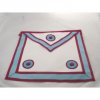Lowcarbjc
Registered User
Without giving away too much. Something I notice at about all lodges I visit on their walls, windows, doors, carved stones, gates etc is something that distinctly makes me think of FC. I do not see this same thing a lot in any other form. Does it just "look" graphically better to the outside world like this or is there another reason why it's is almost always like this?
Sent From My Freemasonry Pro App
Sent From My Freemasonry Pro App




